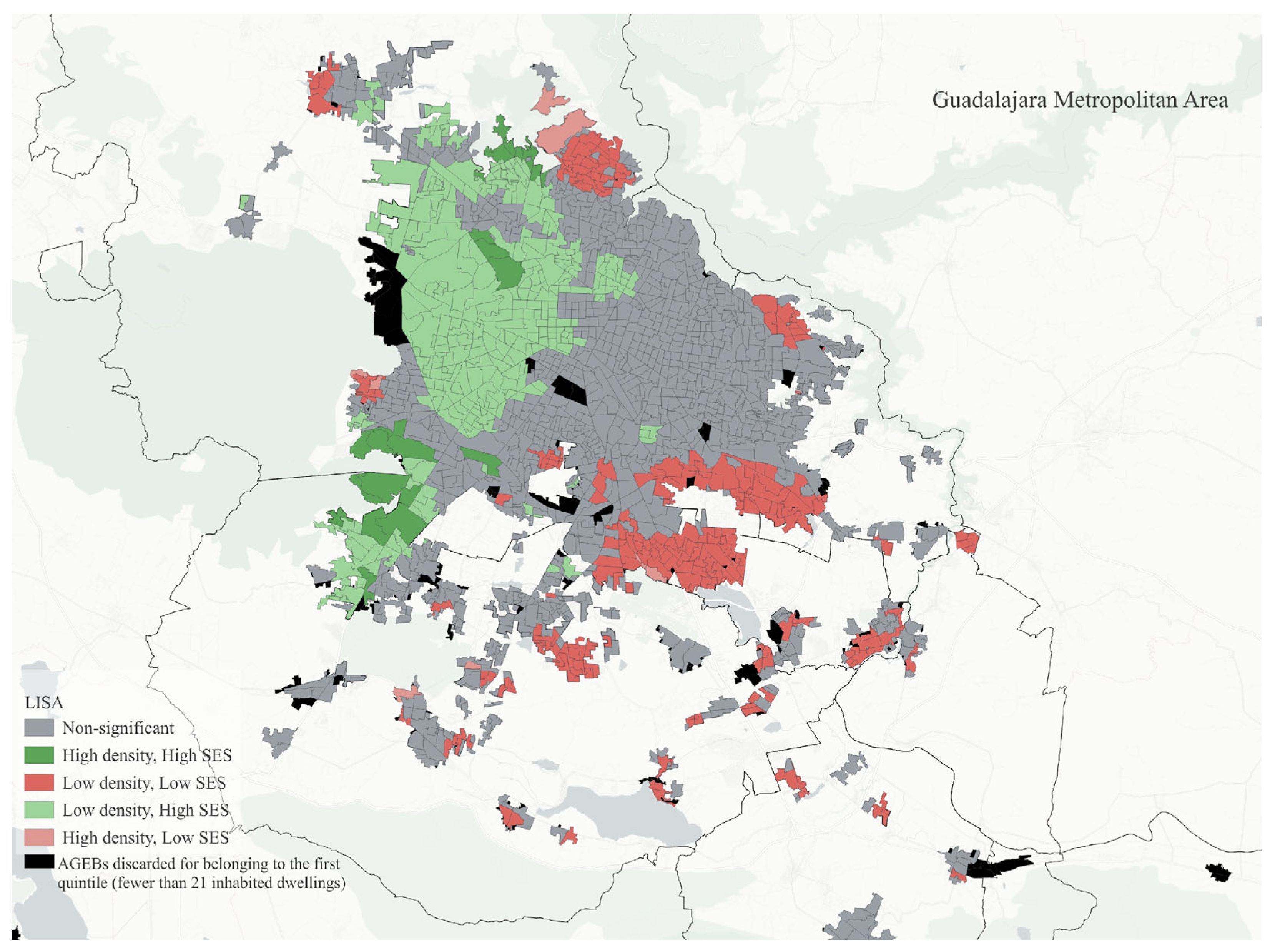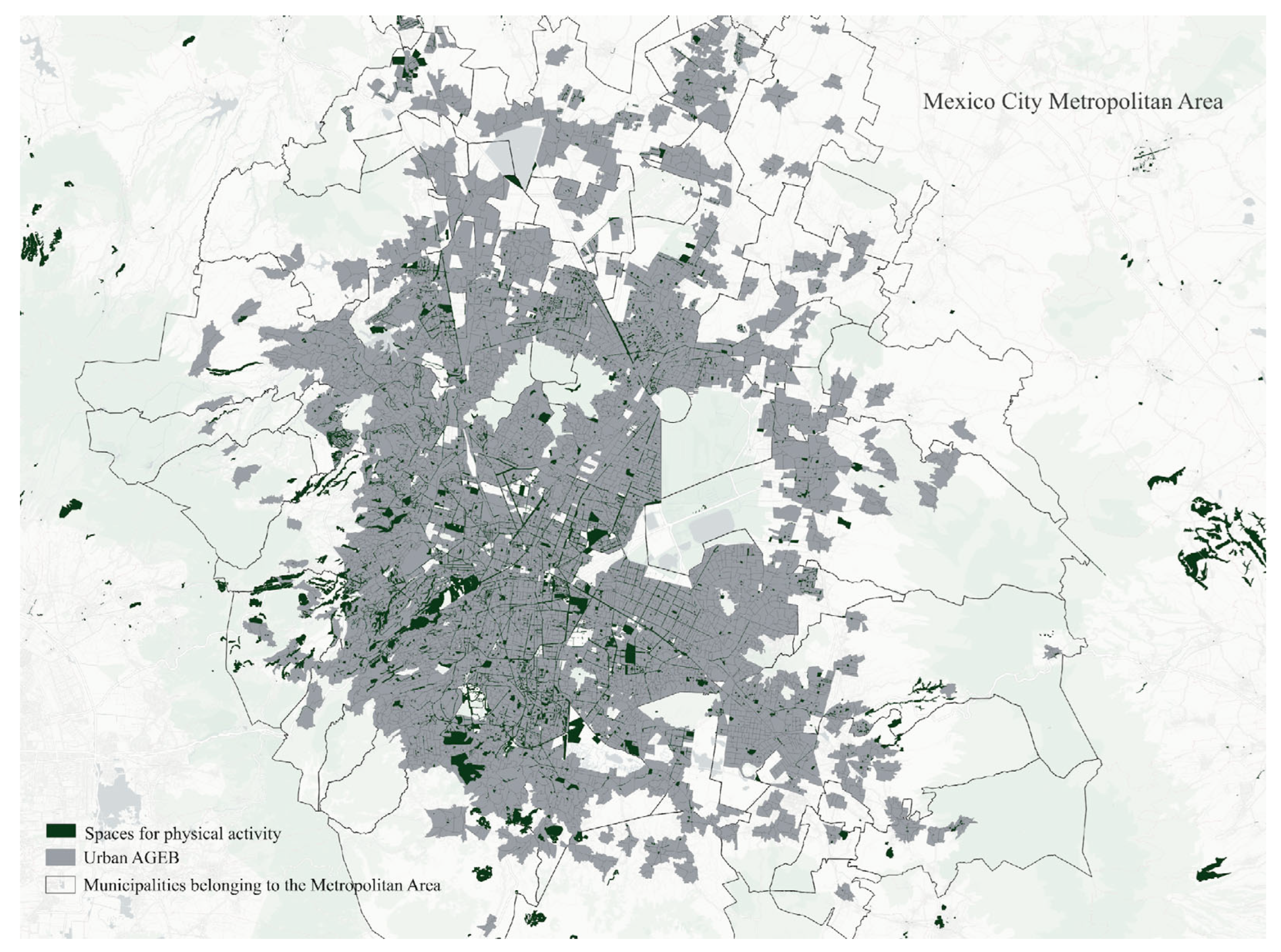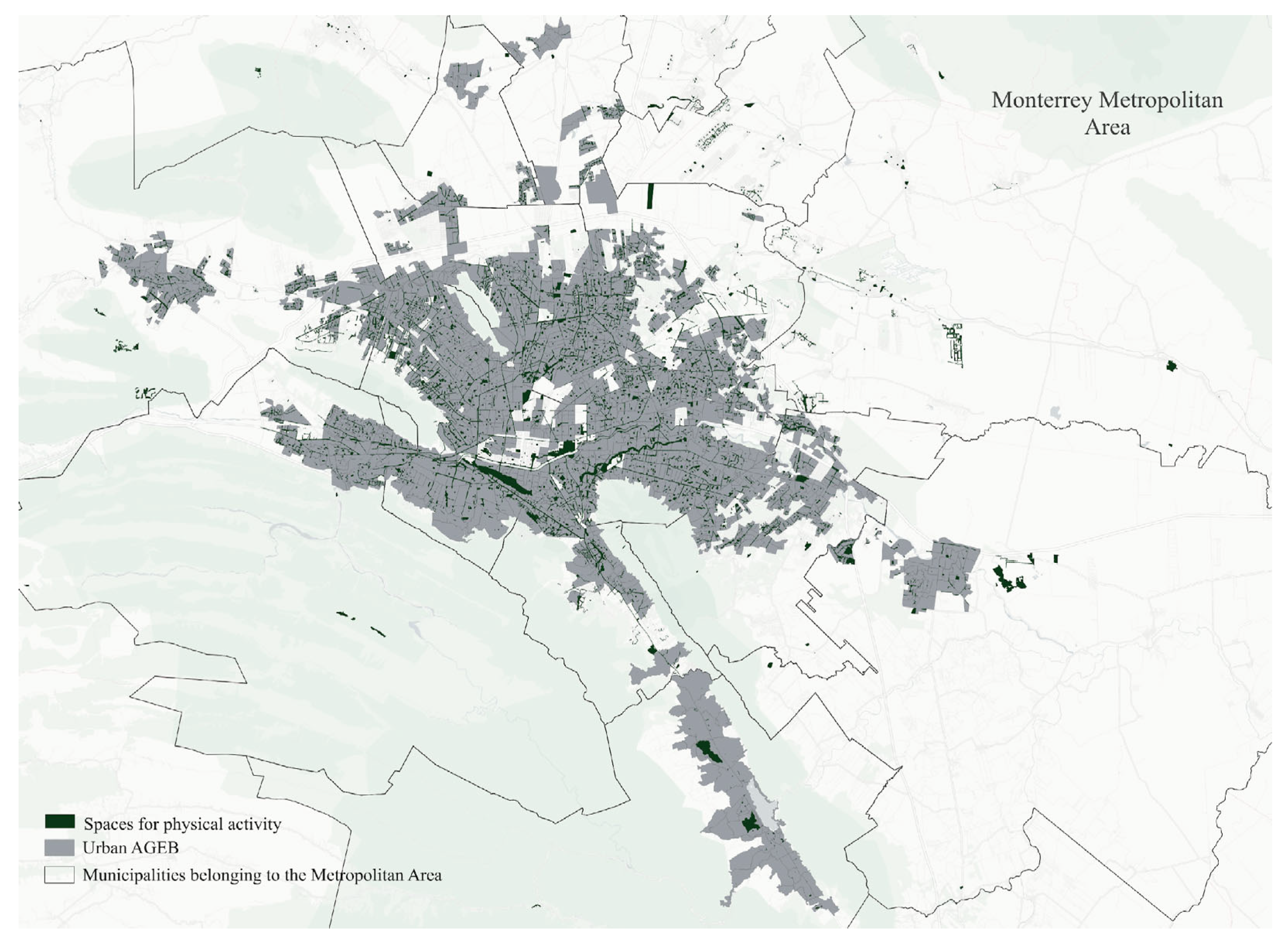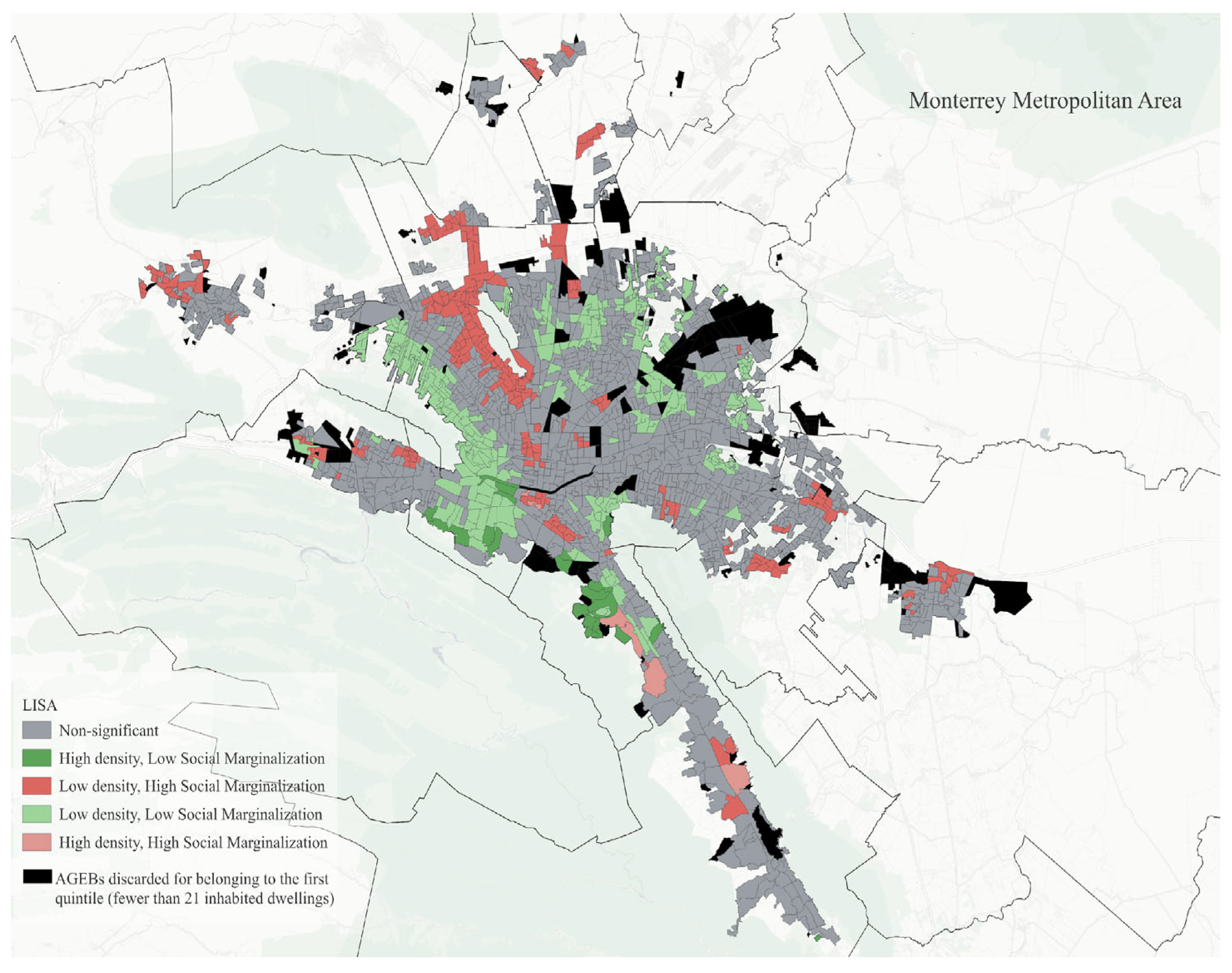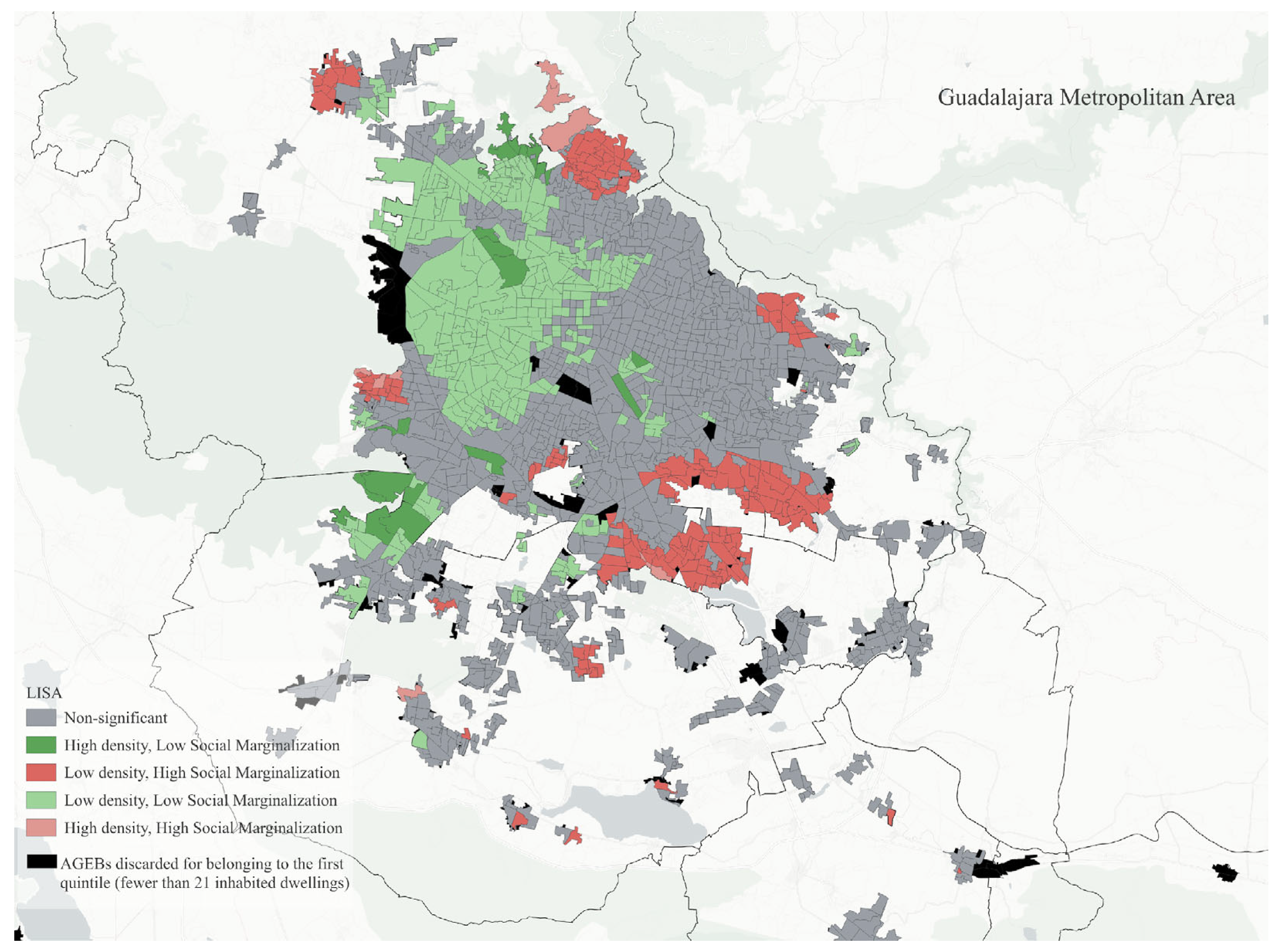1. Introduction
Access to quality public spaces is an essential feature for encouraging physical activity and enhancing public well-being. Physical activity improves physical health by reducing the risk of obesity, cardiovascular disease, and diabetes [
1], and has positive effects on emotional well-being, as it reduces anxiety, depression, and stress, and encourages the development of intellectual and cognitive skills [
2,
3]. Access to parks or green areas has been linked to greater physical activity in children, adolescents [
4,
5] and adults [
6], albeit not consistently. In children and adolescents, the availability of public spaces tends to be associated with greater time for spontaneous outdoor play [
5].
Urban planning guarantees equitable access to public spaces for physical activity [
7]. In Mexico, 82.1% of the population currently lives in urban areas [
8]. However, in many of its cities, distribution of these public spaces is not equitable, potentially creating barriers to physical activity in vulnerable populations [
9,
10]. Planning gaps fail to place people at the center of decision-making to improve their access to and exercise of their human rights, including the right to health.
Disparities in access to spaces for physical activity can contribute to social inequalities in health-related behaviors [
11]. Although there are different forms of physical activity, in the urban context, recreational activity is the most important, since people nowadays spend less time on occupations or modes of transportation that require physical effort. Studies have consistently shown a correlation between higher socioeconomic status and greater engagement in recreational physical activity [
12].
Moreover, the analytical framework developed in this research can be adapted to other metropolitan contexts in middle-income countries, contributing to the portability and scalability of spatial equity assessments. This approach strengthens the evidence base for designing inclusive urban and health policies that promote equitable access to spaces for physical activity, reduce inequalities, and support sustainable urban development [
13].
Research on urban green areas began in the USA and Canada in the early 90s; after that, in Western Europe, the production on this topic increased [
14]. Comparative studies across cities such as Copenhagen, Vancouver, and Melbourne demonstrate that investments in public green infrastructure are associated with higher levels of physical activity, improved social cohesion, and greater perceptions of safety and well-being [
15,
16]. Among middle-income countries, most research has been conducted in China and Brazil, reflecting growing recognition of the links between spatial justice, environmental health, and sustainable urban development [
17,
18]. However, evidence from Latin America remains limited despite rapid urbanization and deep social inequalities, making the Mexican context particularly relevant for advancing global discussions on urban health equity [
19].
Socioeconomic disparities in the availability of green spaces in Mexico City have previously been analyzed [
20,
21,
22]. These studies show that the availability of green spaces tends to be lower in the most marginalized basic geostatistical areas (AGEB). However, these studies have certain limitations, including that they considered only the state of Mexico City, which is part of the Mexico City Metropolitan Area (MCMA). The MCMA includes municipalities from three states (Mexico City, Mexico State, and Hidalgo), which are socially and historically intertwined. Excluding municipalities in Mexico State and Hidalgo from the analysis means that large areas with the worst living conditions in the MCMA were overlooked. Another limitation of this research is that other cities or metropolitan areas were not included. Although Mexico City is one of the states with the largest population, there are other sizable metropolitan areas, including 14 with populations exceeding one million inhabitants [
23]. Although green areas are not equivalent to public spaces for PA, many of them are suitable for this use.
Equitable access to spaces for physical activity must be addressed from a social and environmental justice perspective, since urban design can reinforce or mitigate structural inequalities in health and mobility [
24]. Spatial analysis provides tools for examining the geographical distribution of public spaces and their relationship with health and other factors such as social marginalization. Geographic information systems (GIS) can identify patterns of inequality in urban infrastructure and their impact on health equity [
11]. The objective of the study is to analyze the spatial distribution and availability of public spaces for PA in urban AGEBs in Mexico and their relationship with social marginalization at the AGEB level.
Recent advances in spatial analysis—including the integration of Geographic Information Systems (GIS), remote sensing, and spatial autocorrelation methods—have enabled a more precise understanding of how the geographic distribution of public spaces intersects with social marginalization and health outcomes [
25,
26,
27]. The present study adopts these innovative approaches to analyze the relationship between the availability of public spaces for physical activity and social marginalization at a high spatial resolution, offering a methodological contribution applicable to diverse urban contexts.
2. Materials and Methods
Public spaces for PA were identified through the INEGI National Geostatistical Framework [
28] and OpenStreetMap (for 2024). The National Geostatistical Framework is designed to reference statistical information from INEGI censuses and surveys [
29]. In keeping with the Framework, green areas and medians in urban areas with information updated to 2020 were classified as public spaces for PA. Places associated with public space, such as courts, stadiums, gardens, parks, sports units, recreational areas, and green areas, were also considered. This information was supplemented by OSM, a publicly accessible tool continuously updated by user contributions. We used information collected in April 2024. Due to the different classifications adopted by OSM, places classified as parks, fields, and meadows, and points of interest designated as parks were considered public spaces for PA. To avoid duplication in the associated data from the National Geostatistical Framework and OSM, the database was filtered through geometry and attribute concordance checks to ensure that only single values for physical activity spaces were included.
The study explores urban areas using the AGEB as the unit of analysis because it is the spatial scale that best describes the availability of public spaces for PA in the everyday dynamics of the population. At the same time, only urban AGEBs are studied, because the quality of the information from both the National Geostatistical Framework and the OSM is usually more reliable for these types of settlements than for rural AGEBs. A total of 66,422 urban AGEBs were identified.
To ensure that the analysis was based on AGEBs with a resident population and to explore the surroundings in which this population lived, the AGEBs were divided into quintiles based on the number of inhabited dwellings registered in the 2020 INEGI Population and Housing Census [
29]. AGEBs found in the first quintile, in other words, those that had between 0 and 22 inhabited dwellings, were excluded. This criterion removes units that are predominantly industrial or logistics in function, as well as protected natural areas, where public-space provision patterns are atypical relative to residential contexts. The final number of urban AGEBs analyzed was 50,372.
Once the public spaces for PA and the main urban AGEBs inhabited by the population were determined, we calculated the density of public spaces for PA in each AGEB as the quotient of the number of square meters of public spaces for PA divided by the total population residing in that AGEB, multiplied by 100. Spatial accessibility—including measures such as walking time and transport connectivity—was not explicitly considered in this analysis. We used the density of public spaces for PA as a proxy for potential availability rather than effective accessibility.
The level of marginalization considered is the 2020 Urban Marginalization Index reported by the National Population Council (CONAPO) at the AGEB level [
30]. CONAPO developed the index from the socioeconomic indicators calculated from the 2020 Population and Housing Census, such as the percentages of the population between the ages of six and 14 who do not attend school, the population aged 15 or older who do not have basic education, the population without state health insurance, and occupants of private homes lacking drainage, toilets, electricity, and piped water, with dirt floors, overcrowding, and no refrigerator, internet, or cell phone [
20]. We should emphasize that a higher level on the 2020 marginalization index indicates that the corresponding AGEB has less social marginalization.
We created quartiles from the marginalization index for each metropolitan area. The means and medians of the density of spaces for PA were obtained for each marginalization quartile. We calculated the median in addition to the mean because the space density variable for PA has a right-skewed distribution. The ANOVA test was used to identify differences between the means of the density of areas for PA between quartiles, while the Kruskal–Wallis test was used to test the differences between the medians of the quartiles.
The relationship between the density of public spaces for PA and the marginalization index at the AGEB level was analyzed using the bivariate Moran’s I method and Local Indicators of Spatial Association (LISA) [
31], which were used to construct maps [
32]. We began by defining the proximity between geographical units as the Queen criterion, the most widely used criterion in the literature for this type of spatial modeling, whereby AGEBs with an adjacent edge or a vertex in common are considered neighbors, and subsequently measured whether the value of a quantitative variable in one AGEB had any relationship to the value of another quantitative variable in neighboring AGEBs, weighting by proximity to calculate the global bivariate Moran’s I. A positive overall bivariate Moran’s I value indicates that, in general, high values of one variable at one location tend to be associated with high values of the other variable at neighboring locations. Conversely, LISA maps represent the local spatial association generated by Moran’s I. In other words, regardless of whether there is a global association or correlation, it is possible to visualize clusters of spatial units with a common relationship with neighboring units. The LISA analysis classifies units of analysis into five main categories: non-significant; high levels of both variables; low levels of both variables; a high level of one variable with a low level of the other; and a low level of one variable with a high level of the other. A classification as non-significant indicates that there is insufficient statistical evidence to assume the existence of a correlation between the value of a variable in each spatial unit and the value of another variable in neighboring spatial units [
22].
Since there are marked regional contrasts in Mexico [
33], in addition to the analysis of the entire set of urban AGEBs in the country, separate analyses were also conducted for the subsets of AGEBs in the three most populated metropolitan areas in Mexico, Mexico City, Monterrey and Guadalajara, housing 17%, 4.2%, and 4.1% of the total population of Mexico.
The Marginalization Index measures the degree of deprivations and social disadvantages experienced by the population in a given territory (AGEBs), which may be unrelated to the specific characteristics of the households within it. Therefore, we conducted a sensitivity analysis by re-running the analysis using Moran’s I and LISA, replacing the CONAPO marginalization index with the AMAI index, which is a household socioeconomic level index for Mexico, built by the Mexican Association of Market Intelligence (AMAI by its acronym in Spanish), based on assets, housing conditions, and education of the main earner [
24].
The software used to estimate Moran’s I was GeoDa 1.22 [
31]. The tool used to analyze the spaces for PA of the National Geostatistical Framework and OSM was QGIS 3.36, which made it possible to detect duplicates, eliminate observations that did not correspond to spaces for physical activity, and calculate the area represented by each space and the density of spaces for physical activity in each AGEB (
Figure 1).
4. Discussion
This study identified inequalities in the availability and spatial distribution of public spaces designated for PA across urban AGEBs nationwide and in the three most populous metropolitan areas in Mexico: Mexico City, Monterrey, and Guadalajara. These results indicate a negative spatial association between the marginalization index and the density of spaces for PA in urban AGEBs, confirming previous hypotheses about the influence of social and urban determinants on the accessibility of healthy environments [
7,
34]. As a reminder, higher values of the marginalization index correspond to lower levels of marginalization. This inequality is a critical factor in perpetuating disparities in health and well-being, especially among vulnerable populations. The results reveal an unequal distribution that primarily affects populations with fewer socioeconomic resources, confirming the existence of a social and urban gap restricting access to healthy environments. This situation perpetuates a cycle of health inequality, given that the lack of adequate spaces limits opportunities to adopt the active, healthy lifestyles essential to physical and psychological development [
34]. The results contribute to the discussion on the availability and access to public spaces for PA and their relationship with the well-being of the population.
In the Mexican context, the lack of sufficient PA spaces in the most marginalized areas represents a tangible manifestation of urban inequality in Mexico, restricting recreation and exercise options for the population, particularly the opportunities for children to adopt healthy lifestyles. Among the cities analyzed, Mexico City’s metropolitan area showed the most significant inequity in the coverage of public spaces for PA, as indicated by both the analysis comparing means across marginalization quartiles and the bivariate Moran’s I test. This could be related to the fact that the unequal distribution of these spaces is generally linked to urban policies that have historically favored higher-income areas, sprawling growth, gentrification, and institutional priorities that have privileged areas with greater economic capacity [
35]. Several authors have pointed out that urban planning in large Latin American metropolises tends to reproduce social inequalities through the inequitable allocation of urban resources and services [
36]. By contrast, the Guadalajara Metropolitan Area (GMA) was the least unequal according to the comparison of means by marginalization quartiles. In contrast, the Monterrey Metropolitan Area (MMA) showed an opposite pattern to Mexico City and Guadalajara, as indicated by the bivariate Moran’s I analysis. This could suggest that its urban policies or socioeconomic dynamics promote more equitable distribution of public spaces, constituting good practice. These results may reflect MMA’s historical trajectory as a more industrial and export-oriented metropolis, characterized by faster population and economic growth than MCMA and GMA cases—factors likely to have shaped its urban form and service provision. Consequently, the level of public equipment and amenities may vary according to the planning standards and performance benchmarks that guided its development at different stages. As contextual information, data from the last five census rounds indicate that Mexico City’s population grew by approximately 150%, Guadalajara’s by about 200%, and Monterrey’s by more than 300%, underscoring Monterrey’s distinctive growth dynamics. However, since it may also reflect a general lack of public facilities, the case warrants a more in-depth analysis of the design, implementation, and impact of the public policies involved.
Lack of equitable access to PA spaces is a critical component of environmental injustice, with implications for the physical and mental health of the population, as well as for social well-being and community cohesion [
7,
24]. In Mexico, this inequity reflects and exacerbates existing socioeconomic gaps, disproportionately affecting the most vulnerable groups. Studies of similar urban contexts have shown that access to green spaces is associated with lower stress levels, better mental health outcomes, and greater social cohesion, especially in marginalized communities [
37].
Socioeconomic inequality in PA spaces has been a consistent finding worldwide [
38,
39]. Higher socioeconomic position groups choose to live in the best areas of cities [
40]. They can decide where to reside because they have the financial resources to afford the more expensive areas. In addition, higher socioeconomic position groups have more political power that can influence urban development. In middle- or low-income countries, other processes also explain area-level inequality in PA spaces. The explosive urbanization in these countries was driven by massive migration from rural areas [
14].
In most cases, new dwellers in cities settled in informal areas without basic urban infrastructure. Therefore, in these areas, there were no green areas, parks, or courts. Low political participation and power among low-income people explain the persistence of inequities in PA.
The findings highlight the urgent need for comprehensive, equitable urban public policies that include intersectoral coordination and community participation. The health sector must lead these initiatives, promoting urban planning that prioritizes quality of life and active mobility, especially in areas with high poverty and marginalization rates [
7,
41]. This will reduce environmental and social risks, improve public health, and contribute to more equitable, healthy cities. Furthermore, evidence suggests that multi-sectoral interventions integrating urban planning, public health, and community participation are most effective in reducing inequalities in access to PA spaces [
42].
Measuring socioeconomic status is complex, and health research is compromised if only limited aspects are addressed [
31]. Although we performed a sensitivity analysis using an alternative measure of socioeconomic status, the AMAI socioeconomic status index, it yielded similar results to the main analysis with the Marginalization Index. These results are given in
Figure A1,
Figure A2 and
Figure A3 and
Table A1,
Table A2 and
Table A3 in
Appendix A.
The study has certain limitations. We fully acknowledge that accessibility is a crucial dimension of equity and urban design. We used a density indicator because the data required to compute spatial accessibility indicators—such as walking time or transport connectivity—were unavailable. It should also be noted that the National Geostatistical Framework provided the majority of public-space features and was used as the primary base layer due to its official status. OpenStreetMap (OSM) was incorporated only as a complementary source; however, a full quantitative estimation of error rates in the deduplication process was not conducted. Additionally, the National Geostatistical Framework is designed to support census-taking and large national surveys, rather than to comprehensively quantify public spaces for physical activity; hence, a residual possibility of omission is acknowledged.
The overall correlation identified through the bivariate Moran’s I is relatively weak at the national level. However, when focusing on metropolitan areas, spatial correlations become more pronounced, suggesting that spatial clustering is more evident in densely populated urban contexts. The results of spatial analyses often depend on the scale used. We conducted our study at the scale of Mexican AGEBs, which is the most appropriate spatial unit for the analysis because they offer finer spatial resolution than municipalities or other larger administrative units. In contrast, minor scales often lack reliable or complete information and are also sized in line with the report’s principles: “Providing accessible natural greenspace in towns and cities” [
43].
We based our analysis on a specific spatial correlation methodology. However, in addition to the global bivariate Moran’s analysis, other spatial association tests—Geary’s C and Getis-Ord G—were also conducted. The results are shown in
Appendix B. Briefly, the bivariate Geary’s C result is 0.84, significant at the 99% level, suggesting a moderate positive spatial relationship between both variables. In other words, AGEBs with high marginalization index values tend to be located near units with a high density of spaces for physical activity, and the same pattern is observed for low values. Considering the results of both Moran’s I and the bivariate Geary’s statistic, these findings confirm the existence of a shared spatial dependence between the two variables.
One strength of the study was the inclusion of separate analyses for subsets of AGEBs in the country’s three most populated metropolitan areas, enabling us to observe that Mexican cities may follow a different logic in the distribution of spaces for PA. This finding calls for a contextualized analysis and the proposal of solutions adapted to the specific realities of each region and locality.
5. Conclusions
This study reveals marked inequities in the spatial distribution of public spaces for physical activity across Mexican urban areas, reinforcing cycles of social and health inequality. These disparities vary by city, with low-income census tracts facing compounded disadvantages due to limited access both locally and in surrounding areas.
Urban planning must be revisited to center on people, uphold an equity perspective, and prioritize the public interest over private gain. Designing healthy and livable cities should be both a global and national priority in Mexico, with planning processes aligned to public health, sustainability, and community well-being. Achieving this requires multisectoral coordination and the active participation of communities to ensure that public spaces effectively promote physical activity and inclusion. The development of a national research agenda is also essential to guide urban planning and the equitable design of cities, generating evidence on effective access to and fair use of public spaces for physical activity. Despite limitations in data scope and the cross-sectional nature of the study, these findings provide a solid foundation for future longitudinal and participatory spatial research to inform policies that foster equitable access to public spaces and advance urban health equity.
Future research should also explore temporal changes in public-space availability, assess the impacts of mobility and transportation patterns on access, and apply the proposed spatial workflow to other dimensions of urban inequality—helping to build a more comprehensive evidence base for equitable and healthy city planning.


